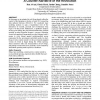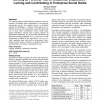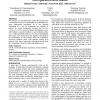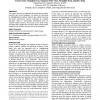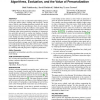CSCW
2012
ACM
12 years 7 months ago
2012
ACM
In this paper we investigate the role blogs played within the context of the Egyptian revolution of early 2011 using blog
CSCW
2012
ACM
12 years 7 months ago
2012
ACM
We examine patterns of participation by employees who are members of multiple online communities in an enterprise communities service. Our analysis focuses on statistical patterns...
CSCW
2012
ACM
12 years 7 months ago
2012
ACM
We describe a social visualization system that monitors the vocal arousal levels of the participants in a simulated twoparty employment negotiation. In a 3x2 factorial experiment ...
CSCW
2012
ACM
12 years 7 months ago
2012
ACM
This paper discusses an approach for transforming solitary exercises into social exergames. We frame our discussion by highlighting the relation between the original exercises and...
CSCW
2012
ACM
12 years 7 months ago
2012
ACM
We have friends we consider very close and acquaintances we barely know. The social sciences use the term tie strength to denote this differential closeness with the people in our...
CSCW
2012
ACM
12 years 7 months ago
2012
ACM
Users have come to rely on automated route finding services for driving, public transit, walking, and bicycling. Current state of the art route finding algorithms typically rely...
CSCW
2012
ACM
12 years 7 months ago
2012
ACM
We report on a study of the English edition of Wikipedia in which we used a mixed methods approach to understand how nested organizational structures called WikiProjects support c...
CSCW
2012
ACM
12 years 7 months ago
2012
ACM
We explore how expert First Person Shooter (FPS) players coordinate actions using a shared voice channel. Our findings emphasize the importance of the temporality and spatiality o...
CSCW
2012
ACM
12 years 7 months ago
2012
ACM
Photoshop with Friends is an online community of learners exchanging just-in-time help on graphic design tasks. The system attempts to provide an interactive, visual, context-awar...
CSCW
2012
ACM
12 years 7 months ago
2012
ACM
In recent years, the HCI and CSCW communities have begun to examine the role technology plays in personal, rather than professional settings. Part of this work has begun to addres...
